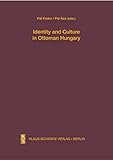Identity and Culture in Ottoman Hungary / ed. by Pál Fodor, Pál Ács.
Material type: TextSeries: Studien zur Sprache, Geschichte und Kultur der Turkvölker ; 24Publisher: Berlin ; Boston : De Gruyter, [2020]Copyright date: ©2020Description: 1 online resource (406 p.)Content type:
TextSeries: Studien zur Sprache, Geschichte und Kultur der Turkvölker ; 24Publisher: Berlin ; Boston : De Gruyter, [2020]Copyright date: ©2020Description: 1 online resource (406 p.)Content type: - 9783879974603
- 9783112209301
- 303.4824390560903 22/ger
- online - DeGruyter
- Issued also in print.
| Item type | Current library | Call number | URL | Status | Notes | Barcode | |
|---|---|---|---|---|---|---|---|
 eBook
eBook
|
Biblioteca "Angelicum" Pont. Univ. S.Tommaso d'Aquino Nuvola online | online - DeGruyter (Browse shelf(Opens below)) | Online access | Not for loan (Accesso limitato) | Accesso per gli utenti autorizzati / Access for authorized users | (dgr)9783112209301 |
Frontmatter -- TABLE OF CONTENTS -- List of Illustrations -- List of Contributors -- Introduction -- BASIC FORMS OF OTTOMAN IDENTITY -- The Formation of Ottoman Turkish Identity (Fourteenth to Seventeenth Centuries) -- The Ottomans and the Mental Conquest of Hungary -- The Library of the Müfti of Buda in the Marsili Collection, Bologna -- NATIONAL IDENTITY IN THE AGE OF OTTOMAN RULE -- Count László Esterházy: The Military Career of a Young West Transdanubian Aristocrat -- “True Hungarian Blood”: Noble Nationalism in the Post-1657 Crisis in Transylvania -- The Image of Ottoman Hungary in Bosnian Heroic Epics -- BORDER-CROSSERS: MULTIPLE IDENTITIES DURING OTTOMAN RULE -- Marriage and Voluntary Conversions in the Hungarian–Ottoman Frontier Region -- The Rise and Fall of a Notorious Renegade: The Story of Sásvár/Şehsuvar Bey, 1580 -- ARTS AND HANDICRAFTS DURING OTTOMAN RULE: IMPACTS AND MUTUAL EFFECTS -- Fate of the Liturgical Equipment of Late Medieval Cathedrals in Hungary in the Early Modern Age -- Ottoman-Balkan Jewellery in Ottoman Hungary: Typology and Spread -- Fashion à la Porte. Was There a Turkish Fashion Trend in Hungarian Aristocratic Homes During the Sixteenth and Seventeenth Centuries? -- The Fight Against the Ottomans in Hungary and the Court Festivals of the Habsburgs in the Sixteenth Century -- From the Turkish Pipes to the Hungarian töröksíp -- THE CHANGING IMAGE OF THE TURKS IN LITERATURE AND FOLKLORE -- Teucri Sive Turci: History of an Ideologically Laden Designation in Fifteenth-Century Latin Works -- The Captivity of Mihály Szilágyi and the Love of the Princess: Evaluating Parallels Between a Hungarian and an Ottoman Turkish Romance -- THE CULTURAL MEMORY OF OTTOMAN RULE -- Vestigia barbarae gentis: Mátyás Bél on Ottoman and Post-Ottoman Hungary -- Index of Names and Places
restricted access online access with authorization star
http://purl.org/coar/access_right/c_16ec
The book offers a balanced and realistic account of the coexistence of different peoples and cultures in Ottoman Hungary. It refrains from either repeating the commonplaces of the sixteenth-century antiturcica literature, or sharing the overtly positive Ottoman-image of the early modern age. The studies of this multidisciplinary book deal with three groups of topics: the historical, literary and art historical approaches combine their methodological merits to paint a colourful picture of Hungary facing or under Ottoman rule. A case study discusses the decay of medieval art heritage, underlining the shared responsibility of the conquerors and the local community. After the re-occupation of Buda (1686), the library of the müfti of Buda passed into Christian hands. The discovery of the catalogue in the Marsili Collection in Bologna is of high importance. Some texts deal with the complexity of Ottoman identity and with the role of the Ottoman establishment in such processes. Cultural exchange is of extreme importance, in conjunction with the changes of identity. Other studies reveal the significance of Hungarian–Ottoman confrontations in the slow emergence of Hungarian national consciousness or deal with the multiple identities of individuals and communities. The authors consider a wide scale of loyalties which – among Christians – bound individuals and communities in the same manner to language, culture, religion, (imagined) comancestry as to the territory, the patria, the country, and the empire. We discover similar tendencies on the Ottoman side, where an abundance of identities coexisted, influencing each other. The book pays special attention to the cultural memory of the Ottoman age, more precisely, to the swift memory loss that followed the rebuilding of the country after it had been reconquered from the Ottomans (Gergely Tóth). Within a few decades following Hungary’s subjection to Habsburg rule the everyday experiences of the Ottoman era had faded away a
Issued also in print.
Mode of access: Internet via World Wide Web.
In English.
Description based on online resource; title from PDF title page (publisher's Web site, viewed 27. Jan 2023)


